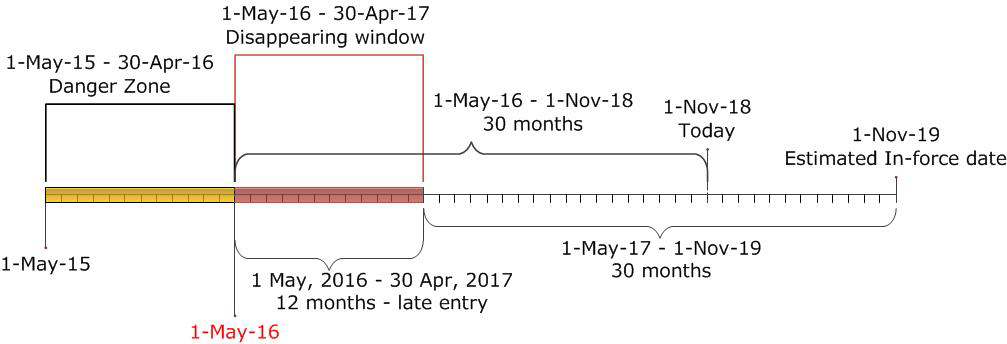


Short Window of Opportunity to Take Advantage of Canada’s Late National Phase Entry Regime
Short Window of Opportunity to Take Advantage of Canada’s Late National Phase Entry Regime
Introduction
Canada is one of a few contracting states to the Patent Cooperation Treaty (PCT) that permits late entry into national phase for an international patent application. Under the current Canadian Patent Rules[1], national phase entry of an international application can be delayed for up to 12 months (42 months from its priority date), with the relatively modest payment of $200 CDN[2]. Moreover, there is no requirement to furnish an explanation for the late entry.
Canada is a Signatory to the Patent Law Treaty
Canada became a signatory to the Patent Law Treaty in May 21, 2001, a little less than a year after the United States which became a signatory on June 2, 2000. The United States ratified the treaty on September 18, 2013, and the treaty came into force in the United States on December 18, 2013.
Canada has yet to ratify the Patent Law Treaty. However, several preparatory steps have already been taken. The Canadian Patent Act was amended in 2014 and in 2015. A review of fee changes was conducted under the User Fees Act in 2016 and the Canadian patent office has held public consultations on proposed amendments to the Patent Rules in 2017.
Canada is now in the process of amending the Patent Rules, and the Canadian patent office is making changes to administrative systems and procedures. Canada is expected to be able to accede to the Patent Law Treaty in late 2019.
Changes to the Patent Rules
Under the proposed new Rule 150(4)(a)(i), excerpted below, it will no longer be sufficient to simply pay the late national phase entry fee, without any explanation, in order to enter national phase in Canada after the expiry of 30 months from the priority date. The applicant will be required to submit to the Commissioner a declaration that the failure was unintentional and a statement of reasons for the failure. Moreover, reinstatement of the right to enter national phase will be discretionary on the part of the Commissioner.
Reinstatement of rights
(4) In respect of an international application, if an applicant fails to comply with the requirements of subsection (1) and, if applicable, subsection (3) before the end of 30 months after the priority date, the applicant is deemed to have so complied within that time period if
(a) before the end of 12 months after that time period, the applicant (i) submits to the Commissioner a request that the rights of the applicant be reinstated with respect to that international application, a declaration that the failure was unintentional and a statement of the reasons for the failure.
A Small Window of Opportunity
As noted above, Canada is expected to be able to accede to the Patent Law Treaty in late 2019. The current requirements for late entry are relatively hassle free and the cost is quite modest.
Figure 1 Hypothetical Example
Suppose Canada’s new Patent rules come into force November 1, 2019 and today is November 1, 2018, as illustrated in the above hypothetical example. Under the current Patent Rules, a PCT application having a priority date of May 1, 2016 could enter national phase in Canada up to November 1, 2018 (i.e., up to 30 months from the priority date) or, with a late entry fee of $200 CDN up to November 1, 2019 (i.e., up to 42 months from the priority date).
If the new Patent Rules come into force on November 1, 2019, then the highlighted window (May 1, 2016 to April 30, 2017 in the illustrated example) may disappear, depending on what transitional provisions are provided. Accordingly, an international application having a priority date (or if no priority is claimed, then a filing date) that is earlier than May 1, 2017 may not be able to enter national phase in Canada after the hypothetical in-force date November 1, 2019 without satisfying the new requirements. Similarly all applications filed after the date that is 42 months prior to the in-force date may have their window of entry into the national phase significantly shortened.
Conclusion
If patent protection is sought in Canada on the basis of an international PCT application, it is advisable to enter national phase as soon as possible. Time is of the essence for international applications whose priority dates are in, or earlier than, the spring of 2017. All international applications with priority dates in the disappearing range as shown should be reviewed for possible entry or late entry into national phase in Canada before the opportunity for doing so disappears.
By Tilaye Terrefe and Keith Bird
Insights (5 Posts)View More
Ontario Employers Beware: Common Termination Language Held Unenforceable
Ontario's Superior Court of Justice found that a termination clause was unenforceable because it gave the employer discretion to terminate "at any time".
Warning For Businesses: Companies Can be Liable for Tort of Bribery Even if They Did Not Intend to Pay or Receive a Bribe
Businesses with a duty to provide impartial advice must take steps to ensure the payments they make or receive are not later interpreted as bribes.
Storm Clouds Looming: The Impact of Competition Act Changes on Leasing
The Affordable Housing and Groceries Act (Bill C-56) recently introduced changes to the Competition Act (Canada) which will govern all landlord and tenant leases and other agreements, not just those of grocery stores
Sidestepping Contracts: The Expansion of Environmental Liability Where The Contractor Is Not Paid
B.C. Court’s decision in Cordy Environmental Inc v Obsidian Energy Ltd opens the door for contractors to sue former owners/operators of contaminated sites.
Amendments to Ontario’s Conservation Authorities Act: Effective April 1, 2024
On April 1, 2024, significant amendments to the Conservation Authorities Act came into effect.
Get updates delivered right to your inbox. You can unsubscribe at any time.







